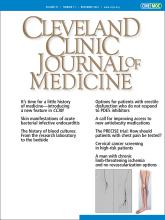Article Figures & Data
Tables
Precision strategy (n = 1,057) Usual-testing strategy (n = 1,046) Intervention Risk stratification using PROMISE minimal risk score: if score was > 0.46, then further testing was deferred unless patients had known vascular calcifications or atherosclerosis
Cardiac testing with CT angiography: if 30% to 90% stenosis was present, then CT fractional flow reserve was addedPhysician-guided decision-making: options included deferred testing, stress testing, or cardiac catheterization Patients who had cardiac testing, n (%) 883 (83.5)a 978 (93.5)a Initial cardiac testing, % CT angiography 48 < 1 CT angiography + CT fractional flow reserve 31 < 1 Cardiac catheterization < 1 10 Single-photon emission computed tomography-positron emission tomography 2 32 Stress echocardiography 2 30 Treadmill electrocardiography 1 11 Stress cardiac magnetic resonance imaging < 1 10 No test 16 7 Patients who had cardiac catheterization, n (%) 135 (12.8)a 177 (16.9)a Patients with primary composite endpoint (death, nonfatal myocardial infarction, or cardiac catheterization without obstructive coronary artery disease), n (%) 44 (4.2)a 118 (11.3)a Death or nonfatal myocardial infarction 18 (1.7) 12 (1.1) Cardiac catheterization without obstructive coronary artery disease 27 (2.6)a 107 (10.2)a Patients who had revascularization, n (%) 97 (9.2)a 54 (5.2)a ↵a Statistically significant difference.
CT = computed tomography; PRECISE = Prospective Randomized Trial of the Optimal Evaluation of Cardiac Symptoms and Revascularization; PROMISE = Prospective Multicenter Imaging Study for Evaluation of Chest Pain
Based on information from reference 7.






